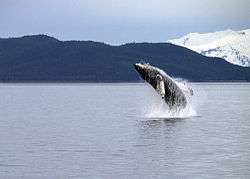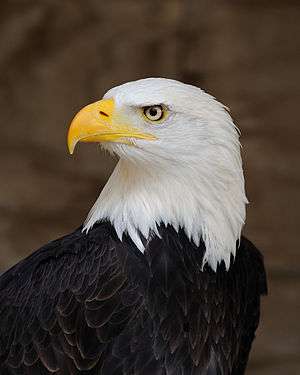Berners Bay
Berners Bay (Daxanaak) is a waterway in the U.S. state of Alaska, approximately 40 miles (64 km) north of Juneau. It is a large and deep indentation, about 3.5 miles (5.6 km) wide at the entrance, which is formed by Point Bridget and Point St. Marys. It runs in a north-northwest direction for 6 miles (9.7 km) from Point Bridget, with a width of 3 miles (4.8 km) opposite Point St. Marys. The bay is surrounded by Tongass National Forest.
Berners Bay | |
|---|---|
Bay | |
 A whale in Berners Bay | |
 Berners Bay Location in Alaska | |
| Coordinates: 58°44′38″N 134°58′16″W | |
| Country | United States |
| State | Alaska |
| Time zone | UTC-9 (Alaska (AKST)) |
| • Summer (DST) | UTC-8 (AKDT) |
History
Berners Bay, Point Bridget, and Point St. Marys were named by George Vancouver during his 1790s expedition to chart the Alaskan coastline; his mother's maiden name was Bridget Berners and she was born in St. Mary's Wiggenhall.[1] Berners Bay was traditionally the place of Wooshkeetaan Auke people who collected blueberries, huckleberries, and nagoonberries at the bay.[2] Auke smokehouses and a village existed near the bay and another village, Kutegan, was situated upstream at the confluence of the Lace River. The bay was used throughout the year by Auke for fishing operations, but is now deserted.[2] The Clinton administration declared it as an Aquatic Resource of National Importance.[3]
Geography and Geology
The bay is an estuary fed by four glacial rivers including the Antler River, Berners, and Lace Rivers, as well as Cowee Creek. It extends 12 miles (19 km) north into the interior.[3][4] The protected cove is called Echo Cove.[5] Extensive flats and several large streams are located at the head.[6] The Berners Bay region forms the northwestern extremity of the auriferous mineralization zone on the mainland of Southeast Alaska known as the Juneau gold belt.[7] It has been proposed to exploit the Kensington gold mine above the bay, but this has been subject to protests.[8]
Gold is found in quartz veins associated with the diorite country rock.[9]
Flora and fauna
Wild blueberries, cranberries, huckleberries and nagoonberries are found here. The bay area is the largest berry picking area for the people of Juneau.[2] Other vegetation, like salmon berry, devils club, and currant, are also reported. The Antler and Lace river mouths contain extensive herbaceous and sedge meadows, known as the Lyngbye's sedge meadows in the area, home to brown bears.[10]

Every spring, millions of hooligan and herring come to the bay to spawn. Nearly 10 to 20 million of these fish lie above the bottom of the bay. The Steller sea lions feed on these hooligans and after feeding they move out of the bay towards the outer coast to breed and give birth to their pups. These sea lions are listed as a threatened species under the Endangered Species Act.[3] It is also a breeding area for various species of Alaskan salmon. There are seals and humpback whales. Other fauna found along the river course upstream of the bay are mountain goats, mink, lynx, moose, wolverine, brown and black bears.[2][3] The bay is reported to have one of the greatest concentrations of bald eagles, reported as the second largest in Southeast Alaska. Also reported around the bay are a very large number of shore birds and seabirds including mallards, pintail, green-winged teal, eagles, and gulls. After the hooligan run ends, which marks the beginning of the spring season, they die and float, and accumulate near the river banks where crows, ravens, and songbirds prey on their carcasses.[2][5]
Tourism
Kayaking from the protected Echo Cove to Berners Bay Cabin, over 8 miles (13 km) away, is a popular sport.[4] The bay is also a recreation area for fishing, watching birds and whales, air boating, and camping.[3]
References
- Engstrom, Elton (June 29, 2007). "Steven's Passage? It's all in a name". Juneau Empire. Archived from the original on 8 December 2015. Retrieved 10 February 2013.
- Goldschmidt, Walter Rochs; Haas, Theodore H.; Thornton, Thomas F. (1946). Our Land. University of Washington Press. pp. 38–. ISBN 978-0-295-97640-2. Retrieved 9 February 2013.
- "Kensington Mine Background". Berners Bay Facts. Alaska Sierra Club organization. Archived from the original on 31 March 2013. Retrieved 11 February 2013.
- "Lonely Planet review for Berners Bay". Lonely Planet.com. Retrieved 10 February 2013.
- Woodford, Riley (May 26, 2002). "Berners Bay Area offers extraordinary opportunity to view wildlife during the hooligan run". Juneau Empire. Archived from the original on 20 November 2015. Retrieved 10 February 2013.
- Nichols, Henry Ezra; Davidson, George; U.S. Coast and Geodetic Survey (1891). Pacific Coast pilot: Alaska. Dixon entrance to Yakutat Bay with inland passage from Strait of Fuca to Dixon entrance (Public domain ed.). U.S. Government Printing Office. pp. 200–. Retrieved 9 February 2013.
- Bastin, Edson Sunderland (1911). Geology of the pegmatites and associated rocks of Maine: including feldspar, quartz, mica and gem deposits (Public domain ed.). Government Printing Office. pp. 7–. Retrieved 9 February 2013.
- "Berners Bay, Alaska". Pew Environmental Organization Trust. Archived from the original on 10 August 2012. Retrieved 10 February 2013.
- Arthur C. Spencer (1906). The Juneau Gold Belt, Alaska, USGS Bulletin No. 287. United States Government Printing Office. p. 15,134–137.
- Bob Christensen & Cheryl Van Dyke (March 2004). "Brown bear (Ursus arctos) habitat and signs of use:Berners Bay, Alaska site survey - June 15-19, 2003, A Seawead report" (pdf). Seawead.org. Retrieved 11 February 2013.